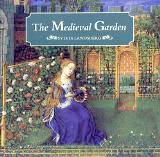-
History of:
- Resources about:
- More:
- Baby walkers
- Bakehouses
- Bed warmers
- Beer, ale mullers
- Besoms, broom-making
- Box, cabinet, and press beds
- Butter crocks, coolers
- Candle snuffers, tallow
- Clothes horses, airers
- Cooking on a peat fire
- Drying grounds
- Enamel cookware
- Fireplaces
- Irons for frills & ruffles
- Knitting sheaths, belts
- Laundry starch
- Log cabin beds
- Lye and chamber-lye
- Mangles
- Marseilles quilts
- Medieval beds
- Rag rugs
- Rushlights, dips & nips
- Straw mattresses
- Sugar cutters - nips & tongs
- Tablecloths
- Tinderboxes
- Washing bats and beetles
- Washing dollies
- List of all articles
Subscribe to RSS feed or get email updates.
Sylvia Landsberg, The Medieval Garden, from Amazon.comor Amazon UK
... in a Gardiner's watering Pot shap'd conically, or like a Sugar-Loaf fill'd with Water, no Liquor fals down through the numerous holes at the bottome, whilst the Gardiner keeps his Thumb upon the Orifice of the litle hole at the top ...
Robert Boyle, New experiments physico-mechanicall, 1660
Alison Sim, The Tudor Housewife, from Amazon.comor Amazon UK

Watering floors and gardens in medieval times, and later
Watering pots, managing dust, sprinkling plants, controlling water flow with your thumb
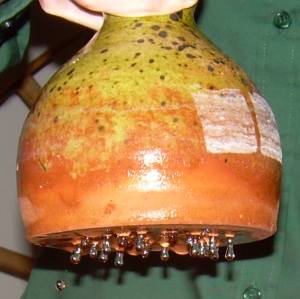 Do you tackle dust in your
home by watering the floor? No, me neither - but perhaps we would if we lived in
a house with rushes spread like carpet on a stone or earthen floor. The replica
15th century English watering pot in the photographs is the kind used in that period
to dampen floors and keep dust from being irritating. Rushes or sometimes straw
were used as floor covering and didn't get replaced all that often. They generated
dust as they disintegrated, and accumulated other dirt too. Dampening everything
down kept it under control. And when it was time to sweep it all away, extra water
would help keep the dust from flying around.
Do you tackle dust in your
home by watering the floor? No, me neither - but perhaps we would if we lived in
a house with rushes spread like carpet on a stone or earthen floor. The replica
15th century English watering pot in the photographs is the kind used in that period
to dampen floors and keep dust from being irritating. Rushes or sometimes straw
were used as floor covering and didn't get replaced all that often. They generated
dust as they disintegrated, and accumulated other dirt too. Dampening everything
down kept it under control. And when it was time to sweep it all away, extra water
would help keep the dust from flying around.
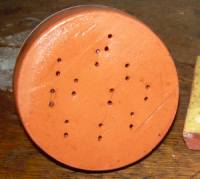 Earthenware pots with sprinkling
holes in the base were used from late medieval times till the 1700s, indoors and
outdoors. The idea is simple. A pot with a thumb-size hole in the top is plunged
into water. It fills up through the holes in the bottom. Put your thumb over the
top and the water won't spray out, for the same reason you can't pour liquid out
of a tiny hole in a can with no room for air to get in. Carry it to where you want
it, remove your thumb and sprinkle the water.
Earthenware pots with sprinkling
holes in the base were used from late medieval times till the 1700s, indoors and
outdoors. The idea is simple. A pot with a thumb-size hole in the top is plunged
into water. It fills up through the holes in the bottom. Put your thumb over the
top and the water won't spray out, for the same reason you can't pour liquid out
of a tiny hole in a can with no room for air to get in. Carry it to where you want
it, remove your thumb and sprinkle the water.
The "immersion" or "thumb" watering pot was a simple rounded clay bottle in a pear or bell shape - usually a few inches across. It could be glazed or unglazed, with a handle or without. In a house it might be used with a pottery basin. Less common were pots with holes in the sides, or expensive metal pots.
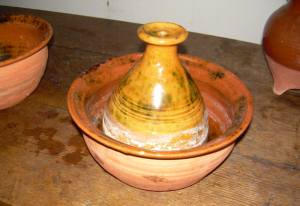 Tackling dust and stopping
it flying around during cleaning was a big part of housekeeping in pre-vacuum cleaner
days. Moisture mattered. Even when wooden floorboards became common it was still
important to "lay the dust" before and/or after sweeping.
Tackling dust and stopping
it flying around during cleaning was a big part of housekeeping in pre-vacuum cleaner
days. Moisture mattered. Even when wooden floorboards became common it was still
important to "lay the dust" before and/or after sweeping.
The flooring of the [London Royal] Academy in 1833.....was nothing but bare boards, watered every morning to keep the dust down. The watering pot was used in similar fashion in...the National Gallery, where as late as 1850 ... the rooms [were] swept every morning ... first strewn with wet sawdust and then swept carefully, so as to raise as little dust as possible.
William Whitley, Art of England 1821-37, 1930
Damp sawdust or wet sand (also good for scouring) could be spread over a stone, brick or wood floor before sweeping - not necessarily using a watering pot. Used tea leaves were an alternative in 19th century Britain. Manufactured "sweeping compounds" with the same aim of not "raising the dust" are available today.
...take some Sand, pretty damp, but not too wet, and strew all over the Room, throwing it out of your Hand hard, and it will fly about the Floor and lick up all the Dust and Flew [fluff]...
Hannah Glasse, The Servant’s Directory, or House-keeper’s Companion, 1760
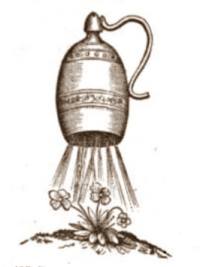 Floors made of flattened earth, or earth mixed with straw were common not only in
the medieval period, but well into the 18th century in Virginia, parts of New England,
the UK outside the south-east, and other parts of Europe. In some climates dampness
was the main problem with earthen floors, but if they were dry and dusty, watering
them would help. Paths were given a sprinkling too.
Floors made of flattened earth, or earth mixed with straw were common not only in
the medieval period, but well into the 18th century in Virginia, parts of New England,
the UK outside the south-east, and other parts of Europe. In some climates dampness
was the main problem with earthen floors, but if they were dry and dusty, watering
them would help. Paths were given a sprinkling too.
The same kind of watering pot, or sprinkling pot, was used in medieval and Renaissance gardens. They would be easy to fill from a pond or trough or pail, perhaps easier than the modern watering can shape with a rose spray head. Both shapes co-existed for some time. This French pot is from 1500 or a bit earlier, and this English one may be as old.
The common watering potte for the Garden beddes with us, hath a narrow necke, bigge belly, somewhat large bottome, and full of little holes, with a proper hole formed on the head, to take in the water, whiche filled full, and the thombe layde on the hole to keepe in the aire, may on such wise be carried in handsome manner...
Thomas Hill, The Gardener's Labyrinth, 1577
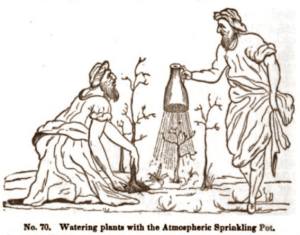 Bottle or gourd shaped ceramic watering pots have been "found on a wide variety
of rural and urban sites at all social levels from the 13th century onwards" according
to
Stephen Moorhouse. Were they used in ancient Greek gardens?
Certainly the author of a 19th century book which copied an illustration from 1616
(see right) believed so. (Thomas Ewbank,
A descriptive and historical account of hydraulic and other machines for raising
water, ancient and modern, 1864) He said they were also used to "drop
water on floors, in order to lay the dust in Greek and Roman houses". He related
what he called the "atmospheric watering pot" to atmosphere and vacuum theories
debated in the 17th century by the philosophers Hobbes and Boyle.
Bottle or gourd shaped ceramic watering pots have been "found on a wide variety
of rural and urban sites at all social levels from the 13th century onwards" according
to
Stephen Moorhouse. Were they used in ancient Greek gardens?
Certainly the author of a 19th century book which copied an illustration from 1616
(see right) believed so. (Thomas Ewbank,
A descriptive and historical account of hydraulic and other machines for raising
water, ancient and modern, 1864) He said they were also used to "drop
water on floors, in order to lay the dust in Greek and Roman houses". He related
what he called the "atmospheric watering pot" to atmosphere and vacuum theories
debated in the 17th century by the philosophers Hobbes and Boyle.
See also:
Garden frames (cucumber frames)
Tudor watering pot
Scrubbing floors and laundry
Notes:
Watering pot can refer to a modern "watering can" shape with spout.
Modern "thumb waterers" are available from some garden equipment suppliers.
 3 July 2009
3 July 2009
You may like our new sister site Home Things Past where you'll find articles about antiques, vintage kitchen stuff, crafts, and other things to do with home life in the past. There's space for comments and discussion too. Please do take a look and add your thoughts. (Comments don't appear instantly.)
For sources please refer to the books page, and/or the excerpts quoted on the pages of this website, and note that many links lead to museum sites. Feel free to ask if you're looking for a specific reference - feedback is always welcome anyway. Unfortunately, it's not possible to help you with queries about prices or valuation.


